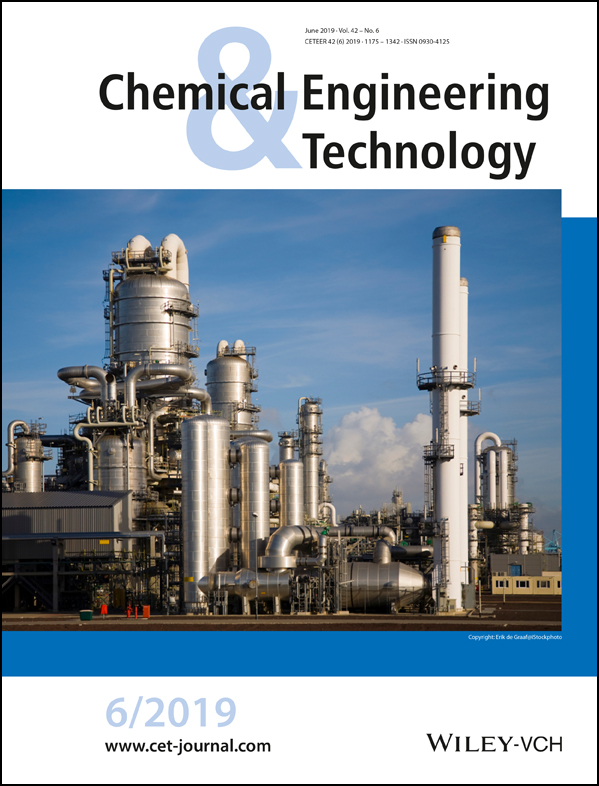Application of Water-Swollen Thin-Film Composite Membrane in Flue Gas Purification
Andrea Žitková
Institute of Chemical Process Fundamentals of the CAS, Department of Membrane Separation Processes, v. v. i., Rozvojova 2/135, 165 02 Prague 6, Suchdol, Czech Republic
Search for more papers by this authorCorresponding Author
Magda Kárászová
Institute of Chemical Process Fundamentals of the CAS, Department of Membrane Separation Processes, v. v. i., Rozvojova 2/135, 165 02 Prague 6, Suchdol, Czech Republic
Correspondence: Magda Kárászová ([email protected]), Department of Membrane Separation Processes, Institute of Chemical Process Fundamentals of the CAS, v. v. i., Rozvojova 2/135, 16502 Prague 6, Suchdol, Czech Republic.Search for more papers by this authorPetr Stanovský
Institute of Chemical Process Fundamentals of the CAS, Department of Multiphase Reactors, v. v. i., Rozvojova 2/135, 165 02 Prague 6, Suchdol, Czech Republic
Search for more papers by this authorJiři Vejražka
Institute of Chemical Process Fundamentals of the CAS, Department of Multiphase Reactors, v. v. i., Rozvojova 2/135, 165 02 Prague 6, Suchdol, Czech Republic
Search for more papers by this authorPavel Izák
Institute of Chemical Process Fundamentals of the CAS, Department of Membrane Separation Processes, v. v. i., Rozvojova 2/135, 165 02 Prague 6, Suchdol, Czech Republic
Search for more papers by this authorAndrea Žitková
Institute of Chemical Process Fundamentals of the CAS, Department of Membrane Separation Processes, v. v. i., Rozvojova 2/135, 165 02 Prague 6, Suchdol, Czech Republic
Search for more papers by this authorCorresponding Author
Magda Kárászová
Institute of Chemical Process Fundamentals of the CAS, Department of Membrane Separation Processes, v. v. i., Rozvojova 2/135, 165 02 Prague 6, Suchdol, Czech Republic
Correspondence: Magda Kárászová ([email protected]), Department of Membrane Separation Processes, Institute of Chemical Process Fundamentals of the CAS, v. v. i., Rozvojova 2/135, 16502 Prague 6, Suchdol, Czech Republic.Search for more papers by this authorPetr Stanovský
Institute of Chemical Process Fundamentals of the CAS, Department of Multiphase Reactors, v. v. i., Rozvojova 2/135, 165 02 Prague 6, Suchdol, Czech Republic
Search for more papers by this authorJiři Vejražka
Institute of Chemical Process Fundamentals of the CAS, Department of Multiphase Reactors, v. v. i., Rozvojova 2/135, 165 02 Prague 6, Suchdol, Czech Republic
Search for more papers by this authorPavel Izák
Institute of Chemical Process Fundamentals of the CAS, Department of Membrane Separation Processes, v. v. i., Rozvojova 2/135, 165 02 Prague 6, Suchdol, Czech Republic
Search for more papers by this authorAbstract
A water-swollen thin-film composite membrane, which was a reverse osmosis membrane with a thin polyamide layer, was used to separate a model mixture of N2, CO2, and SO2. The polyamide swells with water, and thus, becomes more permeable to polar gases. The flue gas contains water vapor, which must be removed before it is subjected to SO2 removal. Here moisture is employed to keep the membrane swollen. Using the model mixture, the humidified feed stream is brought to the membrane, where it is cooled below the dew point, so that water condenses on the membrane to keep the polyamide swollen. The membrane showed high CO2 and SO2 permeance, but low selectivity, so it could be applied to separate these two gases from N2, and thus, is suitable for flue gas purification.
References
- 1
Membrane Processes in Separation and Purification, Vol. 272 (Eds: J. G. Crespo, K. W. Böddeker), Springer Science & Business Media B. V., Dordrecht
1994. DOI: https://doi.org/10.1007/978-94-015-8340-4
10.1007/978-94-015-8340-4 Google Scholar
- 2 C. Coleman, LSU J. Energy Law Resour. 2018, 6 (2), 557–581.
- 3 J. A. Granite, T. O'Brien, Fuel Process. Technol. 2005, 86 (14–15), 1423–1434. DOI: https://doi.org/10.1016/j.fuproc.2005.01.001
- 4 B. Molki, M. B. Aframehr, M. Bagheri, J. Salimi, J. Membr. Sci. 2018, 549, 588–601. DOI: https://doi.org/10.1016/j.memsci.2017.12.056
- 5 A. Ilyas, N. Muhammad, A. M. Gillani, K. Ayub, I. F. J. Vankelecom, A. L. Khaan, J. Membr. Sci. 2017, 543, 301–309. DOI: https://doi.org/10.1016/j.memsci.2017.08.071
- 6 M. Mubashir, Y. Y. Fong, L. K. Keong, C. T. Leng, N. Jusoh, Sep. Pur. Technol. 2018, 199, 140–151. DOI: https://doi.org/10.1016/j.seppur.2018.01.038
- 7 X. Wu, Z. Tian, S. Wang, D. Peng, L. Yang, Y. Wu, Q. Xin, H. Wu, Z. Jiang, J. Membr. Sci. 2017, 528, 273–283. DOI: https://doi.org/10.1016/j.memsci.2017.01.042
- 8 M. A. Rodrigues, J. de Souza Ribeiro, E. de Souza Costa, J. Lopes de Miranda, H. Conceição Ferraz, Sep. Purif. Technol. 2018, 192, 491–500. DOI: https://doi.org/10.1016/j.seppur.2017.10.024
- 9 S. Yeon, K. Lee, B. Sea, Y. Park, K. Lee, J. Membr. Sci. 2005, 257, 155–160. DOI: https://doi.org/10.1016/j.memsci.2004.08.037
- 10 J. Pohlmann, M. Bramm, K. Wilkner, T. Brinkmann, Int. J. Greenhouse Gas Control 2016, 53, 56–64. DOI: https://doi.org/10.1016/j.ijggc.2016.07.033
- 11 M. Sandru, T. Kim, W. Capala, M. Huijbers, M. Hagg, Energy Procedia 2013, 37, 6473–6480. DOI: https://doi.org/10.1016/j.egypro.2013.06.577
- 12 E. Favre, Chem. Eng. J. 2011, 171, 782–793. DOI: https://doi.org/0.1016/j.cej.2011.01.010
- 13 M. Kárászová, J. Vejražka, V. Veselý, K. Friess, A. Randová, V. Hejtmánek, L. Brabec, P. Izák, Sep. Purif. Technol. 2012, 89, 212–216. DOI: https://doi.org/10.1016/j.seppur.2012.01.037
- 14 S. Sridhar, B. Smitha, S. Mayor. B. Prathab, T. M. Aminabhavi, J. Mater. Sci. 2007, 42, 9392–9401. DOI: https://doi.org/10.1007/s10853-007-1813-5
- 15 H. Strathmann, A. S. Michaels, Desalination 1977, 21 (2), 195–202. DOI: https://doi.org/10.1016/S0011-9164(00)80316-1
- 16 S. S. Dhingra, E. Marand, J. Membr. Sci. 1998, 141 (1), 45–63. DOI: https://doi.org/10.1016/S0376-7388(97)00285-8
- 17 C. A. Scholes, S. E. Kentish, W. S. Stevens, Sep. Purif. Rev. 2009, 38 (1), 1–44. DOI: https://doi.org/10.1080/15422110802411442
- 18 G. Huang, A. Pournaghshband, A. Muchtar, K. Sakurai, J. Membr. Sci. 2018, 565, 370–379. DOI: https://doi.org/10.1016/j.memsci.2018.08.026
- 19 L. S. White, X. Wei, S. Pande, T. Wu, T. C. Merkel, J. Membr. Sci. 2015, 496, 48–57. DOI: https://doi.org/10.1016/j.memsci.2015.08.003
- 20 A. Ilyas, N. Muhammad, M. Amjad, K. Ayub, J. Membr. Sci. 2017, 543, 301–309. DOI: https://doi.org/10.1016/j.memsci.2017.08.071
- 21 L. Zhao, Y. Chen, B. Wang, C. Sun, S. Chakraborty, K. Ramasubramanian, P. K. Dutta, W. S. W. Ho, J. Membr. Sci. 2016, 498, 1–13. DOI: https://doi.org/10.1016/j.memsci.2015.10.006
- 22 Y. Chen, B. Wang, L. Zhao, P. Dutta, W. S. W. Ho, J. Membr. Sci. 2015, 495, 415–423. DOI: https://doi.org/10.1016/j.memsci.2015.08.045




